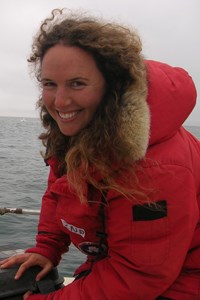
(*Full list of grants on CV)
ERC with Orit Sivan and Guido Grosse, $3M to UAF (in progress).
Colossal Biosciences, Bison. Roslynn King, Colorado School of Mines, Co-PI Katey Walter Anthony, UAF. $90K (pending)
Schmidt Sciences, Virtual Institute for the Carbon Cycle. Rapid Permafrost Thaw Trajectories – PeTCaT, Lead PIs: Guido Grosse, Katey Walter Anthony, Suzanne Tank; Sep. 1, 2025 – Aug. 30, 2030, $1,980,000.
NASA: Characterizing a widespread disturbance regime in the ABoVE domain: Beaver engineering, PI Ken Tape, Oct. 1, 2024 – Sep. 30, 2026, $91,146.
ONRL CenterIce, 2024 Arctic Fellows Award- Mapping dangerous gas holes in Fairbanks area lake ice, PI K. Walter Anthony, Oct. 14, 2024 – Dec. 31, 2024, $9970, FUNDED.
NASA- Methane Emissions from Abrupt Thaw in Saline Permafrost Environments: A Demonstration Project, PI K. Walter Anthony, Sep. 1, 2024 – Dec. 31, 2024, $99,332 (pending).
Tito’s Global Research- Abrupt thaw in permafrost uplands, PI K. Walter Anthony, Jan. 2025 – Dec. 2027, $748,468.
NASA SMAP. Arctic Lake-ice Phenology and Methane Emissions: Can SMAP Observations Shrink the Uncertainties. PI K. Walter Anthony (Univ. Minn. PI: A. Ebtehaj). Mar. 2024-Feb. 2027 $125,059.
NASA ABoVE. JPL Subcontract 1685291. PI K. Walter Anthony (JPL PI Charles Miller). Enhanced Methane Emissions in Transitional Permafrost Environments: An ABoVE Phase 3 Synthesis Investigation. Nov. 2022 - Sep. 2025. $226,123.
Sandia National Laboratories. Improving Biological Fidelity of Arctic Greenhouse Gas Emissions from Permafrost. Dec. 2021-Sep. 2024 $236,000.
NASA FINESST Remote sensing methane superseeps in Alaska. PI. K. Walter Anthony; Ph.D. student, Natalie Tyler. Sep. 2021 – Aug. 2024. $134,668
NSF Atmospheric Sciences 2039276. PI. K. Walter Anthony (RU PI V. Petrenko; Co-PIs T. Curry, C. Alden, G. Rieker, B. Vaughn, T. Curry). Collaborative Research: Geologic Methane Emissions to the Atmosphere: Improving The Bottom-Up Estimates Of Microseepage. Feb. 2021 – Jan. 2024. $46,748
NSF 20-514 Navigating the New Arctic 2022561. PI. K. Walter Anthony (CU PI T. Jones; Co-PIs T. Curry, C. Alden, G. Rieker, B. Vaughn, T. Curry). Title: Collaborative Research: NNA Track 1: Global impacts and social implications of changing thermokarst lake environments near Yukon River Watershed communities. 9/15/20 – 8/31/24. $887,444
NSF AON 1936752. Co-PI. K. Walter Anthony (PI Bret-Harte, Co-PI’s S. Stuefer, A. Kholodov). Collaborative Research: Tracking Carbon, Water, and Energy Balance of the Arctic Landscape at Flagship Observatories in Alaska and Siberia. 7/15/20 – 6/30/25. $2,394,606
NSF P2C2 #1903735. PI K. Walter Anthony [Co-PIs M. Jones (USGS), S. Frolking (UNH)]. Collaborative Research: Sea-level rise, coastal wetland expansion, and proglacial lake contributions to abrupt increases in northern atmospheric CH4 during the last deglaciation. $440,263
NASA ABoVE NNH18ZDA001N-TE. PI K. Walter Anthony (JPL PI Charles Miller). Characterizing Microtopographic Hot-spots and Landscape-scale Methane Emissions Across the ABoVE Domain. Jan. 2019 - Dec. 2021. $499,451
During the International Polar Year, Walter Anthony is working with a team of scientists, teachers, and enthusiastic citizens to establish a methane bubbling monitoring program, the Pan-Arctic Lake-Ice Methane Monitoring Network (PALIMMN), with an education and outreach component, Student-PALIMMN.
The goal of this project is to evaluate the potential for environmentally responsible development of methane gas from seeps near remote Alaskan villages for local space heating and power generation. Research priorities include identifying and evaluating the quantity, quality, and location of natural seeps, as well as determining potential capture and transport mechanisms necessary for future resource development. This project is supported by an NSF EPSCoR Early Career Fellowship and the Department of Energy.
Image above: Thermokarst lake near Cherskii, Russia. Photo by Katey Walter Anthony.
This NSF IPY #0732735 research project integrates field studies in a range of disciplines (geomorphology, geophysics, paleoecology, hydrology, limnology) with process modeling of permafrost thaw, lake formation, carbon cycling, and greenhouse gas emissions to understand how permafrost degradation in the Arctic, particularly thermokarst-lake evolution, affects long-term atmospheric trace gas dynamics by releasing ancient carbon stored in permafrost as carbon dioxide and methane. Intensive study regions are areas of the Yedoma Ice Complex in the Kolyma River Lowlands of Russia and the Seward Peninsula, Alaska.
Lake Methane Ebullution
The goal of this project is to estimate methane emissions from a variety of lake types in Alaska and Russia, with particular attention to the importance of thawing permafrost as a fuel for methane production. We map methane bubbling "hotspots" that come from various sources, not just thawing permafrost, including also decay of modern plants and seepage from geological reservoirs of methane. To date we have mapped over 50 lakes in Alaska and Russia. Using automated bubble traps, we monitor rates of methane bubbling from point sources and hotspots in lakes. Our goal is to understand the origins, magnitude and vulnerability for change of methane emissions from lakes.
Remote Sensing Methane Ebullition
Our goal is to develop a technique to quantify methane bubbling from lakes by linking remote sensing synthetic aperture radar (SAR) to ground surveys of methane bubbles trapped in lake ice for large-scale sampling within images to upscale quantification of regional and pan-arctic lake emissions. This work addresses the NASA Earth Science Enterprise Strategy's objectives of determining how global (aquatic) ecosystems are changing as permafrost warms and thaws enhancing methane emissions from expanding lands and how ecosystems respond to and affect global environmental change and the carbon cycle.
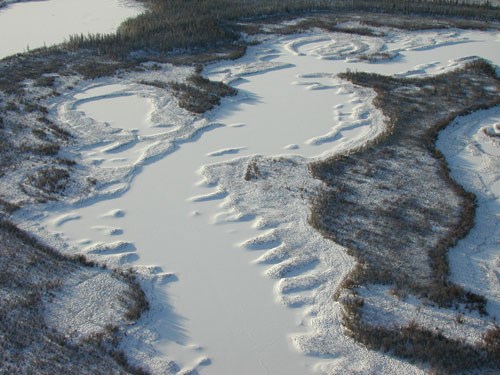
Thermokarst lake near Cherskii, Russia. Katey Walter Anthony.
Thermokarst depressions and thermokarst lakes (TKLs) dominate large areas of the arctic land surface and may expand as permafrost continues to warm and thaw, releasing large quantities of methane (CH4) and carbon dioxide (CO2) to the atmosphere. We propose to define the relationship of TKLs to global climate change by developing remote sensing methods to quantify thermokarst and greenhouse gas (GHG) emissions from TKLs in regions (>1 million km2) of organic-rich, icy permafrost and ice-poor permafrost in Siberia and Alaska. We will use fine and broad scale remote sensing and field validation to determine the role of thermokarst as both a source (GHG release) and sink (peat accumulation) for carbon (C), thereby improving understanding of the behavior of a major C pool (icy permafrost) previously poorly considered in global C cycle sciences. Specifically, we will use remote-sensing based land cover classification and change detection to derive information about thermokarst distribution, initiation, and related changes in land surface properties to improve C-cycle and ecosystem models for Northern Hemisphere permafrost regions. We will test new satellite-based techniques: SAR data will be evaluated for upscaling field-measurements of CH4 bubbling from lakes to regional estimates of lake CH4 emissions through the establishment of a Pan-Arctic Lake-Ice Methane Monitoring Network (PALIMMN). By integration of our remotely sensed spatial data, information derived from multi-temporal satellite data (50 years), radiocarbon dated TKL sediment records (up to ~15,000 years old), and available and predicted climatic data, we will inform the sophisticated 2-D and 3-D numerical permafrost models of our collaborators for prediction of spatial and temporal thermokarst dynamics and related GHG emissions in scenarios for up to 200 years into the future as permafrost warms and thaws under global warming.
Fluxes of carbon, water and energy are major regulatory drivers of the Arctic system, and form key linkages and feedbacks between land, ocean, and atmosphere. They are expected to change rapidly as climate warms. The goal of this IPY NSF project is to establish two long-term observatories at Toolik Lake Field Station in Alaska and the Northeast Science Station in Cherskii, Russia for year-round measurements of landscape-level carbon, water, and energy balance and to contribute to a pan-arctic network where coordinated measurements are made available in a unified database.
In partnership with NOAA, we will measure CH4 concentrations on a 50-meter tall tower in Siberia and use a gradient technique to calculate CH4 flux. Data generated on the tower will contribute to the Global Monitoring Division of NOAA's Earth System Research Laboratory as part of a global greenhouse monitoring network that provides the long-term atmospheric observational basis for improving understanding of the global and North American carbon cycle. This work aims to reduce uncertainties on and improve estimates of CH4 emissions from northern high-latitude ecosystems, and to ensure our ability to detect increases in CH4 emissions resulting from climate change.
The Arctic is central to the global climate change issue, and Russia has by far the largest share of the Arctic. Yet few western scientists, much less students, ever get the chance to work in the Russian Arctic. The NSF POLARIS Project, a joint initiative between the Woods Hole Research Center, University of Alaska Fairbanks and the Northeast Science Station in the Sakha Republic of Russia, will train future leaders in arctic research and education, and inform the public; both tasks are essential given the rapid and profound changes underway in the Arctic in response to global warming.
The goals of our two-phase project are to test and implement cold-adapted biogas digester technology in Cordova, a rural Alaskan community. Successful biogas technology would provide Alaskans with alternative cooking and heating fuel, offsetting fossil-fuel costs, reducing greenhouse gas emission, and minimizing organic waste in dumps. Currently in our first phase, we are experimenting with the relative efficiencies of mesophiles (conventional warm-loving digester microbes from manure) and psychrophiles (cold-loving microbes from thermokarst lake sediments) on common Alaskan household feedstock at various temperatures. The second phase will deploy digesters in practical household scale projects, operating appliances to evaluate feasibility and sustainability for widespread use in Alaska. The project is funded by a Denali Commission Emerging Energy Technology Grant, and is managed in partnership with the Cordova Electric Cooperative and the Cordova High School.
We are also working with a separate grant from National Geographic Society and the Blackstone Ranch in association with engineer T.H. Culhane of the NGO Solar CITIES) to introduce the cold-adapted technology in the high altitudes and latitudes in Africa, Europe, and Asia. This grant includes community education and media coverage to broaden the social appeal of the digester technology.
For a complete list of publications, please see CV and Google Scholar.
2025
Bergman, O., Walter Anthony, K., Eliani Russak, E., Sivan, O. Nitrogen redox controls on greenhouse gas production in yedoma taliks. Global Change Biology 31, e70356. [NSF AON, Tito’s]
Kuhn, M., Olefeldt, D., Walter Anthony, K. M, et al. Current and future methane emissions from Boreal-Arctic wetlands and lakes, Nature Climate Change15, 983-988 [support: NSF NNA]
Liu, J., Young, E. D., Pellerin, A., Sivan, O., Valentine, D., Walter Anthony, K., Treude, T. et al. Methane clumped isotopes reveal the formation mechanism of microbial methane. 2025, Science Advances 11 (26), eadu140, [NSF NNA].
Freitas, N. L., Walter Anthony, K. M., Lenz, J., Porras, R. C., Torn, M. S. 2025. Substantial and overlooked greenhouse gas emissions from deep Arctic lake sediment. Nature Geoscience 18, [NSF P2C2]
Smallwood, C., Hasson, n., Yang, J., Schambach, J., Bennett, H., Ricken, B., Sammon, J., Mascarenas, M., Eberling, N., Kolker, S., Whiting, J., Mays, W., Walter Anthony, K., Miller, P. 2025. Bioindicator ‘fingerprints’ of methane-emitting thermokarst features in Alaskan soils. Frontiers in Microbiology, 15.
2024
Lamb A., Barst, B, Elder, C., Engels, S., Francis, C., van Mardenbroek, M., Heiri, O., Lombino, A., Robson, H., Walter Anthony, K., Wooller, M. 2024. Stable isotope analysis of lacustrine chitinous invertebrate remains: analytical advances, challenges, and potential. QSR 346, 109067. [NSF NNA, NASA ABoVE]
Fuchs, M., Jones, M.C., Gowan, E.J., Frolking, S., Anthony, K.W., Grosse, G., Jones, B.M., O'Donnell, J.A., Brosius, L. and Treat, C., 2024. Methane flux from Beringian coastal wetlands for the past 20,000 years. Quaternary Science Reviews, 344, p.108976.
Brosius, L., K. Walter Anthony, T. Lowell, P. Anthony, J. Chanton, M. Jones, G. Grosse, A. Breckenridge. 2024. Methane emissions from proglacial lakes: A synthesis study directed toward Lake Agassiz. Quaternary Science Reviews, 344, 108975.
Walter Anthony, K. M., P. Anthony, N. Hasson, C. Edgar, O. Sivan, E. Russak, O. Bergman, B. J. Minsley, S. R. James, N. J. Pastick, A. Kholodov, S. Zimov, E. Euskirchen, M. S. Bret-Harte, G. Grosse, M. Langer, J. Nitzbon. Upland Yedoma taliks are an unpredicted source of atmospheric methane. 2024. Nature Communications, 15, 6056 (2024).
Engram, M. J., Walter Anthony, K. M. Synthetic Aperture Radar (SAR) detects large gas seeps in Alaska lakes. Environmental Research Letters, 19, 04403.
2023
Brosius, L.S., Walter Anthony, K.M., Treat, C.C., Jones, M.C., Dyonisius, M., Grosse, G. Panarctic lakes exerted a small positive feedback on early Holocene warming due to deglacial release of methane. Commun Earth Environ 4, 271 (2023).
Jones, M., Grosse, G., Treat, C., Turetsky, M., Walter Anthony, K. M. and Brosius, L. Past permafrost dynamics can inform future permafrost carbon-climate feedbacks. Commun Earth Environ 4, 272 (2023).
Lotem, N., Pellerin, A., Gafni, A., Walter Anthony, K. and Sivan, O. Anaerobic oxidation of methane does not attenuate thermokarst lake CH4 emissions. Limnol. Oceanogr. 68, 1316-1330, (2023). [Support: NASA ABoVE NNH18ZDA001N-TE and NSF NNA 2022561]
Gagné, K. R., Eckhardt, B.A., Walter Anthony, K.M., Barnes, D.L., Guerard, J.J. Dissolved organic matter from surface and pore waters of a discontinuous permafrost watershed in central Alaska reveals both compositional and seasonal heterogeneity. Aquatic Sciences 85, 31 (2023). [Support: NSF NNA 2022577]
Waldrop, M. P., Chabot, C. L., Liebner, S., Holm, S., Snyder, D., Dillon, M., Doughlas, T. A., Leewis, M. C., Walter Anthony, K., McFarland, J. M., Conaway, C. H. Arp, C. D. Bondurant A., Tas, N., Mackelprang, R. Permafrost microbial communities and functional genes are structured by latitudinal and soil geochemical gradients. 2023. ISME J}
2022
Strauss, J., Laboor, S., Schirrmeister, L. Fedorov, A. N., Fortier, D. Froese, D. Fuchs, M., Gunther, F. Grigoriev, M., Harden, J., Hugelius, G., Jongejans, L. L., Kanevskiy, M. Kholodov, A., Kunitsky, V., Kraev, G., Lozhkin, A., Rivkina, E., Shur, Y., Siegert, C., Spektror, V., Streletskaya, I., Ulrich, M., Vartanyan, S., Veremeeva, A., Walter Anthony, K, Wetterich, S., Zimov, N., Grosse, G. 2022. Circum-Arctic Map of the Yedoma Permafrost Domain. Cryospheric Sciences, 10.3389/feart.2021.758360
Strauss, J, Bias, C., Sanders, T., Abbott, B., Schneider von Deimlingt, T., Voigt, C., Winkel, M., Marushchak, M., Kou,, D., Fuchs, M., Horn, M., Jongejans, L., Liebner, S., Nitzbon, J., Schirrmeister, L., Walter Anthony, K. M., Yang, Y., Zubrzycki, S., Laboor, S., Treat, C. and Grosse, G. A globally-relevant stock of soil nitrogen in the Yedoma permafrost domain. 2022 Nature Communications 13, 6074.
Pellerin, A. N. Lotem, K. Walter Anthony, E. Russak, N. Hasson, H. Roy, J. P. Chanton, O. Sivan. Methane production controls in a young thermokarst lake formed by abrupt permafrost thaw. Global Change Biology, 28(10), 3206-3221. 2022.
2021
Kuhn, M. A., Varner, R. K., Bastviken, D., Crill, P., MacIntyre, S., Turetsky, M., Walter Anthony, K., McGuire, A. D., Olefeldt, D. 2021. BAWLD-CH4: A Comprehensive Dataset of Methane Fluxes from Boreal and Arctic Ecosystems. Earth Syst. Sci. Data, 13, 5151-5189,
Elder, C. D., Thompson, D. R, Thorpe, A. K., Chandanpurkar, H. Hanke, P., Hasson, N. James, S., Minsely, B., Pastick, N. J., Olefedlt, D., Walter Anthony, K., Miller, C. E. 2021. Characterizing methane emission hotspots from thawing permafrost. Global Biogeochemical Cycles.
Strauss, J., Laboor, S., Schirrmeister, L. Fedorov, A. N., Fortier, D. Froese, D. Fuchs, M., Gunther, F. Grigoriev, M., Harden, J., Hugelius, G., Jongejans, L. L., Kanevskiy, M. Kholodov, A., Kunitsky, V., Kraev, G., Lozhkin, A., Rivkina, E., Shur, Y., Siegert, C., Spektror, V., Streletskaya, I., Ulrich, M., Vartanyan, S., Veremeeva, A., Walter Anthony, K, Wetterich, S., Zimov, N., Grosse, G. 2021. Circum-Arctic Map of the Yedoma Permafrost Domain. Cryospheric Sciences, 10.3389/feart.2021.758360
Walter Anthony, K. M., Lindgren, P., Hanke, P., Engram, M., Anthony, P., Daanen, R. Bondurant, A., Liljedahl, A., Lenz, J., Grosse, G., Jones, B., Brosius, L., James, S., Minsley, B., Pastick, N., Munk, J. Chanton, J., Miller, C., Meyer, F. 2021. Decadal-scale hotspot CH4 ebullition in lakes following abrupt permafrost thaw. ERL 16, 035010.
Sullivan, T. D., A. D. Parsekian, J. Sharp, P. J. Hanke, F. Thalasso, M. Shapely, M. Engram, K. Walter Anthony. 2021. Influence of permafrost thaw on an extreme geologic methane seep. PPP 1-19.
Stolpmann, L., Coch, C., Morgenstern, A., Boike, J., Fritz, M., Herzschuh, U., Stoof-Leichsenring, K., Dvornikov, Y., Heim, B., Lenz, J., Larsen, A., Walter Anthony, K., Jones, B., Frey, K., and Grosse, G.: First pan-Arctic assessment of dissolved organic carbon in lakes of the permafrost region, Biogeosciences, 18, 3917–3936, 2021.
Treat, C. C., M. C. Jones, L. Brosius, G. Grosse, K. M. Walter Anthony, S. Frolking. The role of wetland expansion and successional processes in methane emissions from northern wetlands during the Holocene. Quaternary Science Reviews, 257 (2021) 106864.
Brosius, L., K. M. Walter Anthony, Treat, C., Lenz, J., Jones, M., Bret-Harte, M. S., Grosse, G. Spatiotemporal patterns of northern lake formation since the Last Glacial Maximum. Quaternary Science Reviews, 253 (2021) 106773
…
For a complete list of publications, please see CV and Google Scholar.
Arctic Fellows Award, Office of Naval Research CenterIce University Alaska Fairbanks, 2024
Achievement Award, Alumnae Association of Mount Holyoke College, 2023
Emil Usibelli Distinguished Research Award, University of Alaska Fairbanks, 2019
UAF CEM Researcher of the Year award, 2019
WINGS WorldQuest 2011 Elected Fellow. http://explore.wingsworldquest.org/node/722
National Geographic Society Early Explorers, awarded Feb. 2009, biographical article in NGS Magazine about scientist and her research. $10,000. http://www.nationalgeographic.com/field/explorers/walter-katey-09.html.
Mount Holyoke College Alumnae Association Mary Lyon Award, 2010.
National Wildlife Federation: National Conservation Achievement Award in Science, presented November 2009, Washington DC.
Ecological Society of America 2006 most notable publication
United States Council of Graduate Schools/ UMI Distinguished Dissertation 1st Place Award in Science, Math & Engineering 2006 ($1,000)
Sigma Xi, 1998
New Eight Scholar-Athlete, 1995, 1997
Sarah Williston Scholar, 1996
Rhodes Scholarship finalist, 1998
Seven Sisters Scholar Athlete, 1998
Phi Beta Kappa, 1998
Mildred L. Sanderson Prize in Math, 1995
SPARK Climate Solutions, Bio-Methane Removal Workshop, San Francisco, California, Nov. 21-23, 2024.
National Academies of Sciences, Engineering and Medicine. Member of the Committee on Atmospheric Methane Removal: Development of a Research Agenda. Feb. 2023- Dec. 32, 2024.
United States White House, Office of Science and Technology Policy, invited speaker at the Roundtable on Countering Delayism and Communicating the Urgency of Climate Action, Feb. 24, 2022. Deputy Director for Climate & Environment, Jane Lubchenco
National Academy of Sciences, Polar Research Board - board member Sep. 2013 – June 2019
United States White House, meeting with White House Science Advisor, John Holdren Aug. 29, 2015, IARC UAF
Manuscript reviews for refereed journals: Science, Nature Geoscience, PNAS, PlosOne, Journal of Geophysical Research-Biogeosciences, Journal of Geophysical Research-Atmospheres, Biogeochemistry, Geobiology, JAWRA, Limnology & Oceanography, Limnology & Oceanography: Methods, Global Biogeochemical Cycles, Philosophical Transactions of the Royal Society A, Aquatic Botany, NICOP, UNEP, AMAP, others. 2007-present.
Proposal reviewer: NSF, NASA, NOAA Climate Program Office, ALW Klimaatvariabiliteit, Royal Society of New Zealand Marsden Fund, UAF Global Change Student Grant, others. 2007-present.
ESRI Storymaps. GRID/UNEP Rapid Response Assessment (RRA) on coastal and offshore permafrost; Collaboration with Scott Dallimore, Aug. 31, 2020.
Methane on Earth HWK Study group, Sep. 2018-present
International Permafrost Association, member 2007 to present
ABCFlux v2, collaborator May 2023
Permafrost Pathways, collaborator on ABC flux, May 2023 to present
Q-Arctic, collaborator May 2023 to present.
GreenFeedback, collaborator May 2023 to presen.
NASA ABoVE, member of Scientific Team, Oct. 2015-present
Permafrost Carbon Network, member 2014-present.
Vulnerability of Permafrost Carbon Research Coordination Network Synthesis Group, sponsored by NSF, World Climate Research Programme, USGS, DOE. 2011-2014.
PAGE21 Changing Permafrost in the Arctic and its Global Effects in the 21st Century, European Commission. Scientific advisory committee, 2011-present.
POLARIS Project Summer Field School in Cherskii, Russia, Instructor in NSF sponsored short summer course for U.S. and Russian undergraduate students, 2007-2009.
National Center for Ecological Analysis and Synthesis (NCEAS) for the “Toward an adequate quantification of CH4 emissions from land ecosystems: Integrating field and in-situ observations, satellite data, and modeling." 2006-2009.
Arctic Council, AMAP/CliC/IASC Arctic Carbon Cycle Assessment Workshop, Seattle. Invited participant, February 2007.
Alaska Forum on the Environment: Invited speaker and panelist on permafrost thaw and changes in arctic lakes in Climate Change Session, Anchorage, Alaska, February 2007.
Royal Society/ Novartis Foundation Discussion Meeting on Methane, Ozone and Environmental Change, London England, Invited presentation on Methane emissions from arctic lakes: present and future contributions to the global atmospheric methane budget. November 15, 2006.
NSF SEARCH CHAMP Scientific Steering Committee, 2006.
U.S. Senate, Transatlantic Symposium on How Changes in the Arctic Climate are Affecting the Rest of the World, invited presentation on Permafrost Thaw in the Arctic; hosted by the Royal Norwegian Embassy and EESI, June 15, 2006.
The Evolving Arctic Workshop Series: Hydrologic Responses to Degrading Permafrost, Aug. 2005. International Arctic Research Center, Fairbanks, Alaska. One of three invited student participants. Appointed leadership and coordination of writing the section report for the workshop.
NSF Russian-American Initiative on Land-Shelf Environments in the Arctic (RAISE) Synthesis Workshop, St. Thomas, USVI. June 2005. Presentation. One of two students. Invitee.
NSF Arctic System Science (ARCSS) Program Synthesis Retreat, Lake Tahoe, CA. August 2004.
One of three invited student participants. Contribution to synthesis paper for publication.
American Water Resources Association (AWRA), 2004. Alaska Chapter Annual Meeting. Fairbanks, Alaska, Invited Presentation.
NSF ARCSS All-hands workshop, Seattle, WA. Presentation, Rapporteur, February, 2002.
VRT Public Television, Belgium. Fieldwork interview at Big Trail Lake with Daan Wallis, Aug. 1, 2025.
Weather Channel. Interview by Alicia Eakin about upland yedoma methane release, Aug. 13, 2024.
KUAC. Alaska News Nightly and interview about upland yedoma methane release, Robyne, Aug. 11, 2024.
Mongabay. Interview about arctic methane synthesis; Liz Devitt, May 2, 2024.
Halal.il and Olam_il. In-the-field interview with Israeli brothers, Ariel and Jonathan Haresh, for global Hebrew audiences Instagram videos about thermokarst lake methane, March 26, 2024.
EOS. Big Trail Lake research featured. Interviews and article by Jenessa Duncombe, April 26, 2023.
Biologos. Interview about thermokarst lakes and climate change in the Arctic with Colin Hoogerwerf, Nov. 10, 2022.
Counterpunch. Interview with John Hawkins about Chasing Lakes, Nov. 1, 2022.
NASA’s Expeditions blog. Interview and filming at Big Trail Lake with Peter Griffith, Elizabeth Hoy, Katie Jepson and Sofie Bates, Sep. 21, 2022.
Alaska Gateway School District, spent a day with K-12 Tok school science teacher, Andrea Braatz, showing her my research on permafrost thaw and training her in measurements of greenhouse gas fluxes in lakes near Tok, Alaska, Sep. 12, 2022.
Transmedia Vision Inc. Interview and filming of thermokarst methane in interior Alaska for climate restoration documentary film entitled, ‘Back To Our Future’ with John Bowey, Aug. 18, 2022.
Financial Times. Interview with Leslie Hook about the permafrost carbon feedback. Friday, July 8, 2022.
Yale University. Interview for Climate Crocks with Peter Sinclaire.
Alaska Daily News and Fairbanks Daily News Miner, Ned Rozell.
Newsweek. Interview with Hanna Osborne about methane sinkholes in the Arctic, May 16, 2022.
National Security This Week on KYMN Radio. Interview with Jon Olson, May 25, 2022
World Christian Broadcasting. Interview with Paul Ladd about Chasing Lakes and methane research, May 23, 2022.
Synapse School, Menlo Park, CA. Teachers Anna Chang and Mike Lee, Question and answer session with 7th & 8th graders class on Alaska climate and permafrost, May 16, 2022.
Curiousmans Podcast. Interview with Mathew Crawford and discussion of Chasing Lakes, May 9, 2022.
Project Save the World. Interview about permafrost with Metta Spencer, Apr. 21, 2022.
This is Not Church Podcast, Interview about Chasing Lakes, permafrost and methane with Jon and Nat Turney; May 23, 2022.
BYU Radio. Interview with Marcus Smith for Constant Wonder, March 21, 2022.
White House Office of Science and Technology Policy. One of 16 scientists and climate change communications at an event sponsored by Jane Lubchenco, Deputy Director for Climate and Environment. The event focuses on understanding the costs and risk associated with delaying action on climate change. February 24, 2022.
KTVF Channel 11, Fairbanks. Interview with Richard Atkin about arctic methane, Feb. 15, 2022.
…
For a complete list of publications, please see CV.
The videos below show phenomena associated with methane release in lakes.
This video, recorded 2009, on a lake near Fairbanks, shows Walter Anthony and a research team drilling a hole through lake ice, then lighting the escaping methane. This video was shot by Megan Otts and Todd Paris of UAF Marketing and Communications.
This video shows a large plume of methane-rich gas continuously bubbling in a tundra lake in Alaska. In the background is a rubber raft used by researchers to explore field sites and collect data. Katey Walter Anthony made this recording in the summer of 2007.
This video shows a researcher burning a plume of methane-rich gas as it bubbles up through the water of a tundra lake in Alaska. Researchers visit winter field sites, cut the ice over the plume (which was located during the summer field season), and light the escaping gas. The steady flames indicate the presence of the methane. Walter made this recording in the spring of 2008. At the end of the end, the video pans out to show a larger view of the lake and the research team. Appearing are (left to right) Melissa Smith, Dennis Witmer, Paul Bodfish, and Thomas Ahmakak Itta.
This video, taken in January 2008 (by Peter Anthony), shows Katey Walter opening thin ice overlying the methane seep at Atqasuk. High rates of bubbling prevent thick ice from forming, and gas escapes from the seep year-round to the atmosphere through cracks in the ice.
This video was shot under the lake ice in April 2008 (by Dennis Witmer). It shows the ice-free cavern generated by a violent bubbling plume that is active year-round. The milk jug frozen in place is a buoy, anchored to the lake bottom for seep location identification in summertime. Here it gives an idea of the scale of the cavern.
The event as Described by Dennis Witmer:
"The seep flows so strongly that it disrupts the normal ice formation on this lake. The ice on the lake was about four feet thick, but directly over the seep, the ice was only about a foot thick and porous. We made a hole over the top of the seep to make some measurements, but noted that every time we took ice or water out of the hole that the level dropped -- not what you would expect from floating ice. From this we deduced that the seep must have made a dome in the ice, with ice frozen to the bottom along the edges, but forming a dome of thinner ice over the seep. We then deliberately removed about 200 gallons of water (we counted 40 five-gallon buckets full) and discovered that we had dropped the water level about 16 inches from the top of the ice. I then took my digital camera in movie mode and made the video. The seep can be seen with the vigorous bubbling of the water. You can also see a white plastic milk jug frozen to the top. This was a float that Katey had used to mark the seep last summer so she could easily find it from the air. I shot only a few seconds of video before I lost my nerve; I realized that the chamber in the top of the dome was a mixture of air and methane and could have been an explosive mixture -- I didn't want to ignite the mixture from a spark from the camera."
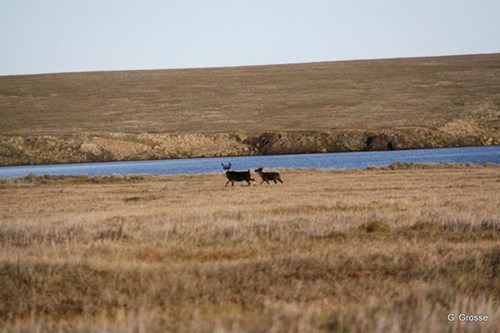
August 2009 on Chuckochki Cape, in Russia's Far East. Katey Walter Anthony and colleagues spotted these reindeer escaped from their heard as they climbed up a nearby permafrost exposure to peer into the thermokarst lake basin in the forefront of the photo. Guido Grosse.
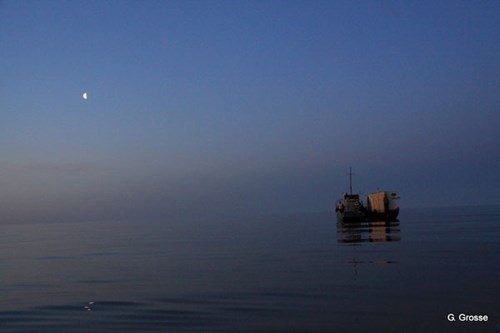
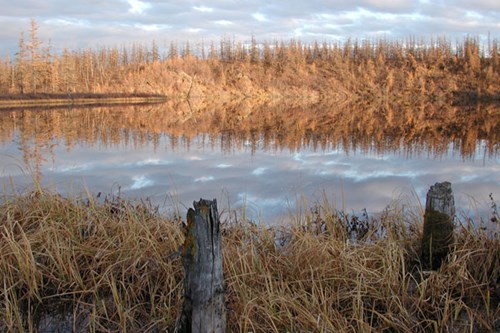
Tube Dispenser Lake in Cherskii, Russia, September 2003. Katey Walter Anthony made long-term methane measurements. On this day she and her field assistant worked from a rubber raft gathering samples. At the time of this photo they were drying by a small wood fire after the wet sampling. Katey Walter Anthony.

Professor Terry Chapin and Katey Walter Anthony as his graduate student in May 2001. Chapin and Walter Anthony are struggling to separate a tube containing lake sediments from the core head. They are standing on a thermokarst lake near Cherskii, Russia. Melissa Chapin.

Katey Walter Anthony is extracting a methane bubble trap from a thermokarst pond near Cherskii, Russia in 2001. Only about a decade earlier, this was a forest area underlain by icy permafrost. The ice is melting, so the ground surface subsides. The sink hole filled with water forming a pond. This pond will continue to help thaw the permafrost around it, eventually expanding into a large thermokarst lake. Nikita Zimov

This photo taken in May 2001 by Terry Chapin shows Katey Walter Anthony in the first year of PhD research probing the shallow seasonal depth of thaw in a recently drained thermokarst lake basin near Cherskii, Russia. Terry Chapin.
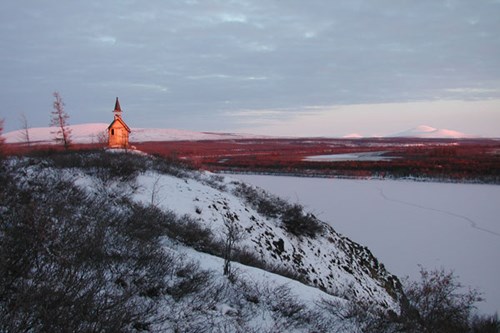
Alpenglow highlights a Russian church in this view from the look out of the Northeast Science Station in Cherskii September 2004. The science station served as a base from which research by founder and director, Sergey Zimov, and others on Siberian Yedoma permafrost has been conducted since the 1980s. Katey Walter Anthony.
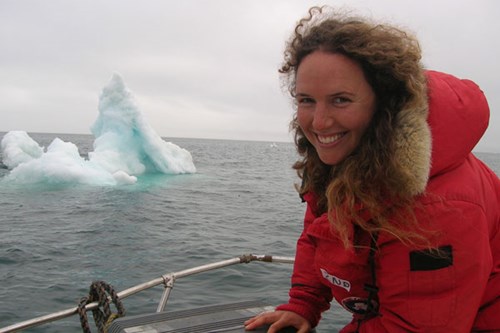
Katey Walter Anthony on a 2007 expedition for hydrochemistry off the coast of Alaska. Gemma Atwal.
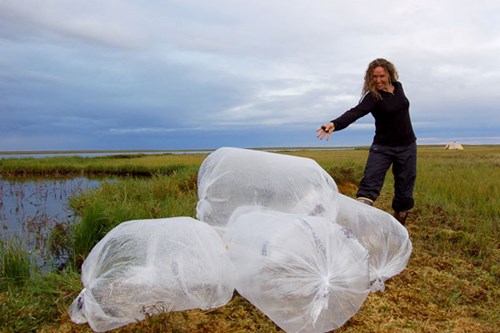
Katey Walter Anthony shows methane collected into large plastic bags from a strong geologic seep at Qualluraq Lake on Alaska's North Slope. Moments later we lit a match and observed a great explosion, demonstrating the seep composition as methane. Methane is flammable and also an important greenhouse gas, which is released daily from millions of seeps across Alaska. Gemma Atwal.
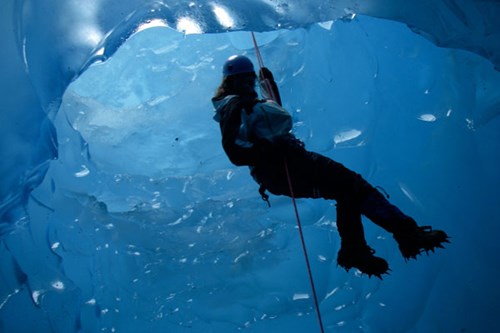
Katey Walter Anthony descends through the bottom of glacial ice near Juneau, Alaska in July 2007. Katey is studying methane production and emissions in environments where glaciers are melting and ice retreating. Michelle Koppes.
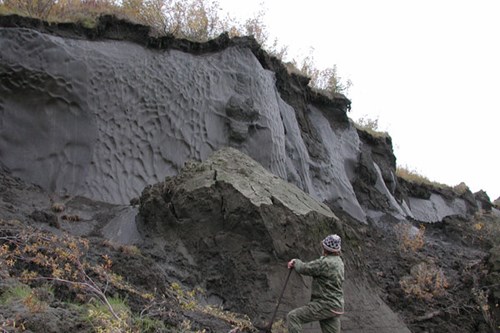
Sergey Zimov, Director of the Northeast Science Station in Cherskii, Russia stands near the base of this massive exposed Yedoma permafrost ice wedge in this August 2001 photo taken at Duvanni Yar. The soil trapped behind the ice wedge is high in organic content. When this Yedoma permafrost melts the carbon is made available to microbes which produce carbon dioxide and methane. Katey Walter Anthony.